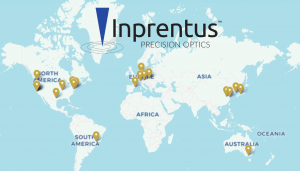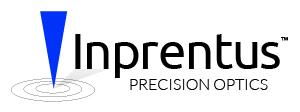Inprentus Diffraction Gratings Continue to Grow a Global Presence
Inprentus continues to serve critical global customers on 5 continents.
Inprentus was originally awarded a Small Business Innovation Research (SBIR) grant, as part of the US government’s commitment to investing in small business innovation and to demonstrate support for US technological advancements and commercialization efforts. This SBIR grant was crucial for Inprentus to develop its groundbreaking technology and production infrastructure, foster partnerships for testing and refinement, attract private sector investments, and to ultimately successfully commercialize a novel diffraction grating production method.
“The SBIR Program is critical to technology companies like Inprentus because it allows small businesses access to research dollars,” explained Inprentus founder Peter Abbamonte. “Through this SBIR investment, Inprentus’ original R&D efforts have strengthened US technological expertise, bolstered the manufacturing economy, and contributed to Midwest manufacturing job growth.”
Today, Inprentus maintains an 11,000 square-foot production facility in the heart of the Midwest, employing a unique blend of scientists, engineers, technicians, and support staff dedicated to executing the company’s vision. Inprentus’ blazed gratings are distinguished by advanced features such as their wide range of blaze angles, variable line spacing, high resolving power, line densities up to 6000 l/mm, high damage threshold, and flexible sizing.
Since its inception, Inprentus has served the mission of the SBIR by selling their ground-breaking diffraction gratings to a multitude of international government research facilities on 5 continents. In the United States, Inprentus has delivered to facilities including the Advanced Light Source Berkeley (11 gratings), Brookhaven National Laboratory (5 gratings), Stanford Linear Accelerator (7 gratings), Argonne National Laboratory (1 grating). In Europe, customers include the Paul Scherrer Institute Switzerland (1 grating), European Xray Free Electron Laser Germany (3 gratings), and Laboratorio de Luz de Sincrotron Spain (6 gratings). In South America, Inprentus has delivered 4 gratings to the Laboratorio Nacional de Luz Sincrotron. In Asia, customers include Pohang National Accelerator in Korea (1 grating), Shanghai Xray Free Electron Laser (1 grating), SHINE Shanghai (1 grating), National Synchrotron Radiation Laboratory (3 gratings), Shanghai Synchrotron Radiation Facility (3 gratings), and Synchrotron Light in Tohuku Japan (2 gratings). In addition, Inprentus has served private sector customers in Augmented Reality, EUV, DUV, and Spectroscopy markets in Australia, the UK, Austria, Slovakia, and Japan.
“Although we also serve a domestic market, we would not be able to grow our business without the increasing demand from our international customers. Orders from our international partners have helped to sustain our business and allowed us to refine and perfect our technology through the marketplace” explained Subha Kumar, Inprentus’ COO. “Unfortunately, retaliatory tariffs threaten to negatively affect our business, due to our reliance on an international customer base”.
“Inprentus is proud of our history of advancing US technology and manufacturing job growth. We will continue to be the world leader in blazed high precision diffractive optics” say Jeff MacDonald, Inprentus interim CEO. “Common sense trade policy will help companies like Inprentus continue to dominate world markets”
Inprentus Inc.
Inprentus was founded in June 2012 by University of Illinois Urbana-Champaign physics professor Peter Abbamonte to commercialize an innovative, dual-atomic microscope scribing technology, which is a technique for carrying out nano-scale lithography via mechanical deformation of metallic surfaces. This technology is a general purpose approach to high-precision patterning of surfaces, and is particularly suited diffractive optics in which features must be shaped with 0.1-degree angular precision and positioned with nanometer precision over distances of tens of centimeters.
Inprentus aims to apply 21st century mechanical ruling to solve critical current and future grating-centered challenges. We are committed to excellence, risk, and pushing boundaries by providing state of the art blazed gratings that perform to unprecedented specifications and that enable novel applications. Outcomes include next-generation monochromators, spectrometers, laser systems, and analytical instrumentation in defense applications, as well as ground-breaking consumer experiences enabled by improvements in chip manufacturing and see-through AR waveguides. Inprentus is dedicated to facilitating next-level science and technology by continually enhancing our capabilities with cutting-edge developments, collaborations, and partnerships.
Cynthia Ottemann
Inprentus, Inc
+1 2174930905
email us here
Visit us on social media:
LinkedIn
Facebook
X
Legal Disclaimer:
EIN Presswire provides this news content "as is" without warranty of any kind. We do not accept any responsibility or liability for the accuracy, content, images, videos, licenses, completeness, legality, or reliability of the information contained in this article. If you have any complaints or copyright issues related to this article, kindly contact the author above.
The Aku Venue Event Center, LLC Earns 2025 Best of South Carolina Award for Excellence in Event Hosting and Planning
Pre-Orders Opened on July 18 for 'Guts Berserker Armor ‘Rage’' Plastic Model Kit
A Voice of Light: Viviana Puello’s Journey Through Music, Film, and Soul
Kalendarium
Więcej ważnych informacji
 Jedynka Newserii
Jedynka Newserii

 Jedynka Newserii
Jedynka Newserii

Prawo

KE proponuje nowy Fundusz Konkurencyjności. Ma pobudzić inwestycje w strategiczne dla Europy technologie
W środę 16 lipca Komisja Europejska przedstawiła projekt budżetu na lata 2028–2034. Jedna z propozycji zakłada utworzenie Europejskiego Funduszu Konkurencyjności o wartości ponad 400 mld euro, który ma pobudzić inwestycje w technologie strategiczne dla jednolitego rynku. Wśród wspieranych obszarów znalazła się obronność i przestrzeń kosmiczna. Na ten cel ma trafić ponad 130 mld euro, pięciokrotnie więcej niż do tej pory.
Firma
Były prezes PGE: OZE potrzebuje wsparcia magazynów energii. To temat traktowany po macoszemu

Choć udział odnawialnych źródeł energii w miksie energetycznym Polski jest stosunkowo wysoki i rośnie, to ten przyrost jest chaotyczny i nierównomiernie rozłożony miedzy technologiami – wskazuje Forum Energii. Dodatkowo OZE potrzebują wsparcia magazynów energii, a zdaniem Wojciecha Dąbrowskiego, prezesa Fundacji SET, ten temat jest traktowany po macoszemu. Brak magazynów powoduje, że produkcja energii z OZE jest tymczasowo wyłączana, co oznacza marnowanie potencjału tych źródeł.
Infrastruktura
Wzrost wynagrodzeń ekip budowlanych najmocniej wpływa na koszty budowy domu. Zainteresowanie inwestorów mimo to nieznacznie wzrasta

Budowa metra kwadratowego domu w Polsce kosztuje od 5,55 do 6 tys. zł w zależności od województwa – wynika z najnowszych analiz firmy Sekocenbud. Najdrożej jest w Warszawie, gdzie cena za metr kwadratowy domu przekroczyła już 6,2 tys. zł. Na przyrosty kosztów budowy domu wpływają zarówno drożejące materiały budowlane, jak i wyższe wynagrodzenia pracowników. Inwestorzy nie rezygnują jednak z budowy domów jednorodzinnych, co ma związek m.in. z wciąż wysokimi cenami mieszkań czy też obniżką stóp procentowych.
Partner serwisu
Szkolenia

Akademia Newserii
Akademia Newserii to projekt, w ramach którego najlepsi polscy dziennikarze biznesowi, giełdowi oraz lifestylowi, a także szkoleniowcy z wieloletnim doświadczeniem dzielą się swoją wiedzą nt. pracy z mediami.










.gif)

 |
| |
| |
|